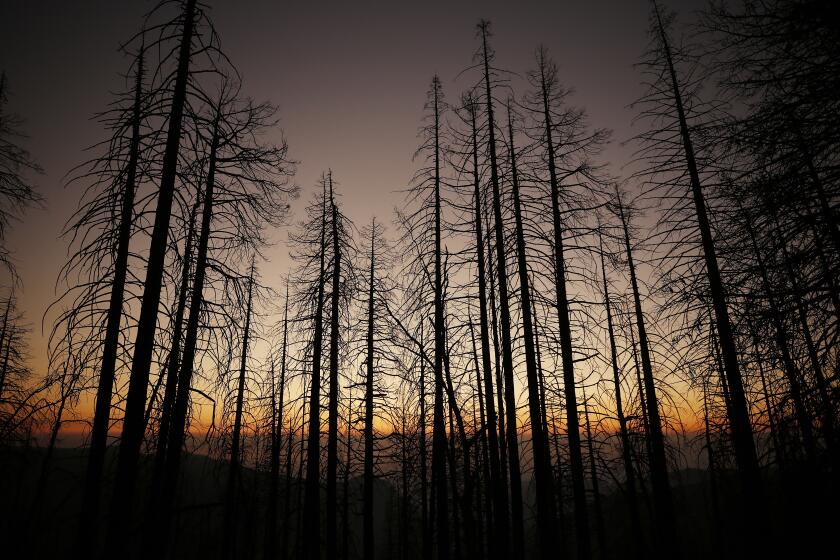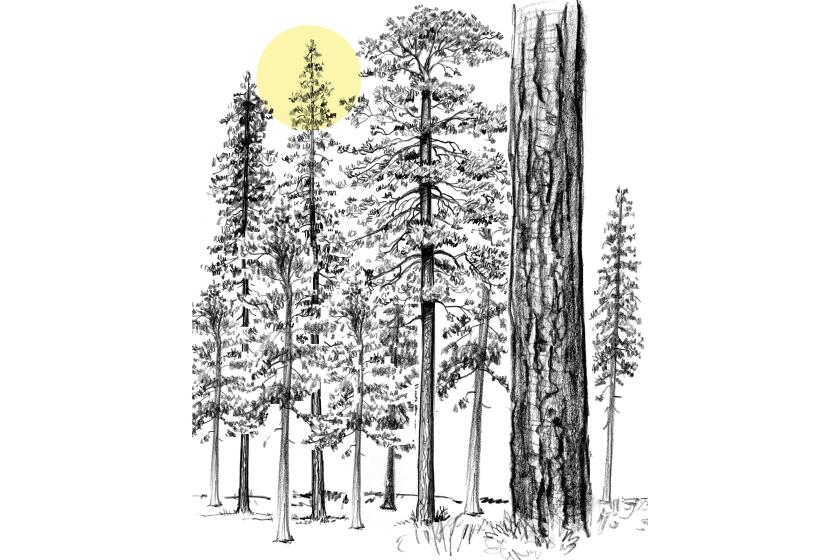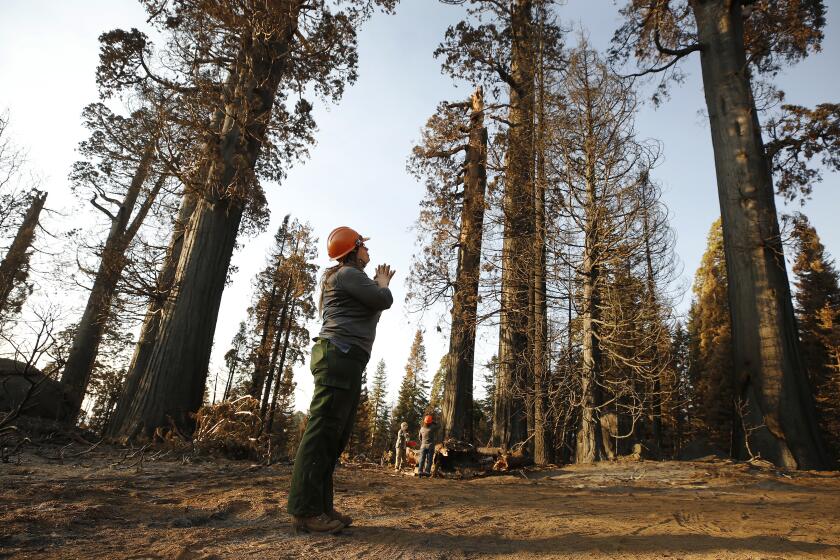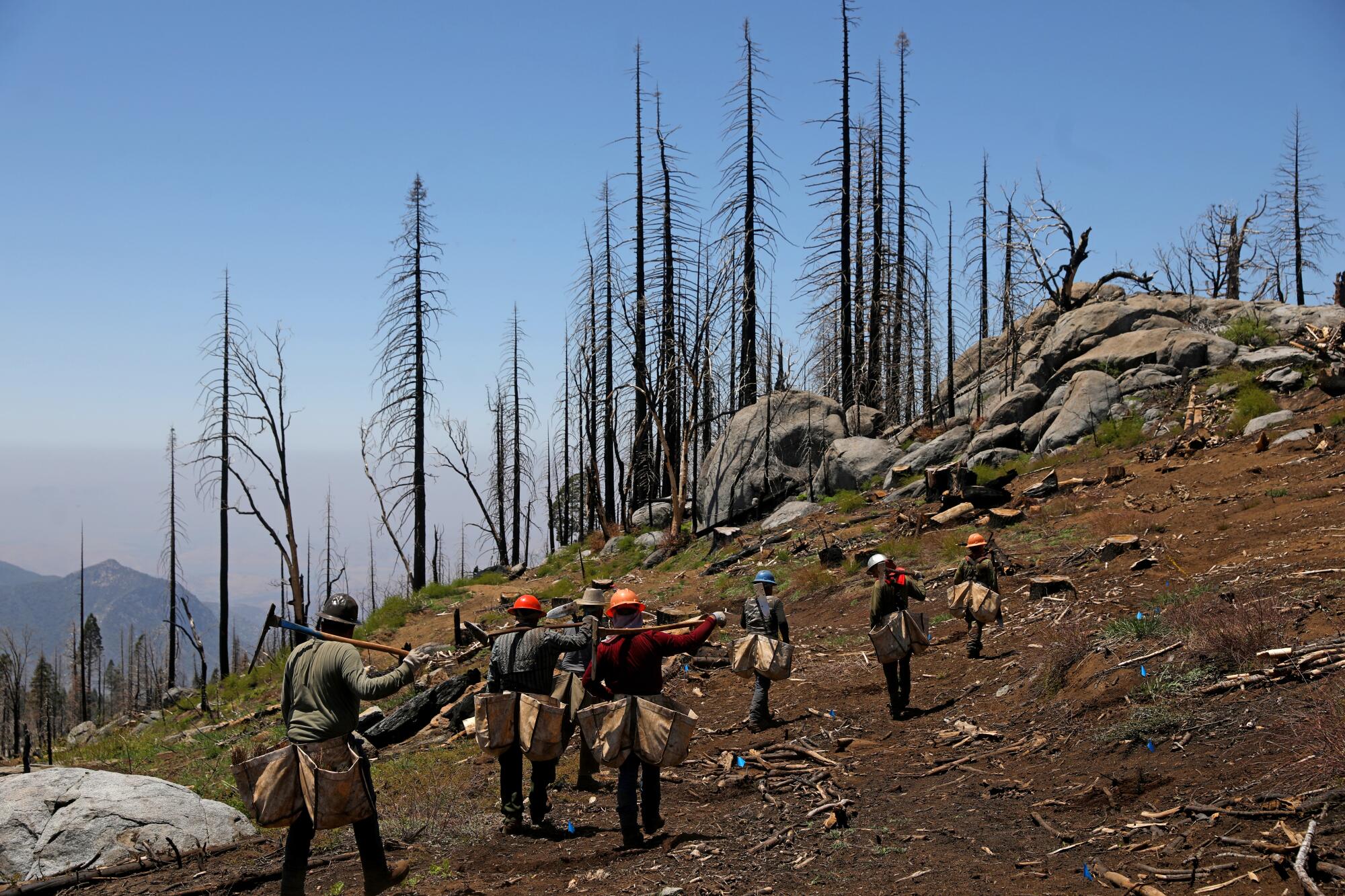
- Share via
SEQUOIA CREST, Calif. — The worker stabbed the loamy soil with a hoedad, dropped in a delicate sequoia seedling and tamped the dirt tight around it. As he moved on to the next spot, and then the next, the hillside of the Alder Creek Grove slowly filled with small clumps of green needles.
Without this planting, naturalists worry giant sequoias will never grow on this charred hillside again. The wildfire that scorched this southern Sierra Nevada forest three years ago burned large swaths of land so intensely that it left thousands of ancient giants dead and smoldering. Their seed cones — which would ordinarily spawn new life — were incinerated.
Such devastation was once unheard of but is now happening more frequently as land management decisions and climate change create more flammable forests in the Sierra.
“Giant sequoia are going through an existential crisis,” said Tim Borden, of the Save the Redwoods League. “And I think all of us who are involved in giant sequoia research and management are going through the same existential crisis ourselves to really try to understand what’s going on ... and what we can do about it.”
Researchers now believe a wildfire last year killed 10% to 14% of the world’s natural sequoia population.
Some of the 30,000 sequoias planted in this grove could grow to be among the world’s largest trees and live for thousands of years — if they first survive the next couple of decades. Scientists are hoping this project will help them learn how to ensure that happens.
The Forest Service is also planting about 10,000 giant sequoia seedlings across 1,380 acres of high-severity burn areas in the Sequoia National Forest. The National Park Service is drafting an environmental assessment evaluating the effects of planting seedlings in Sequoia and Kings Canyon National Park.
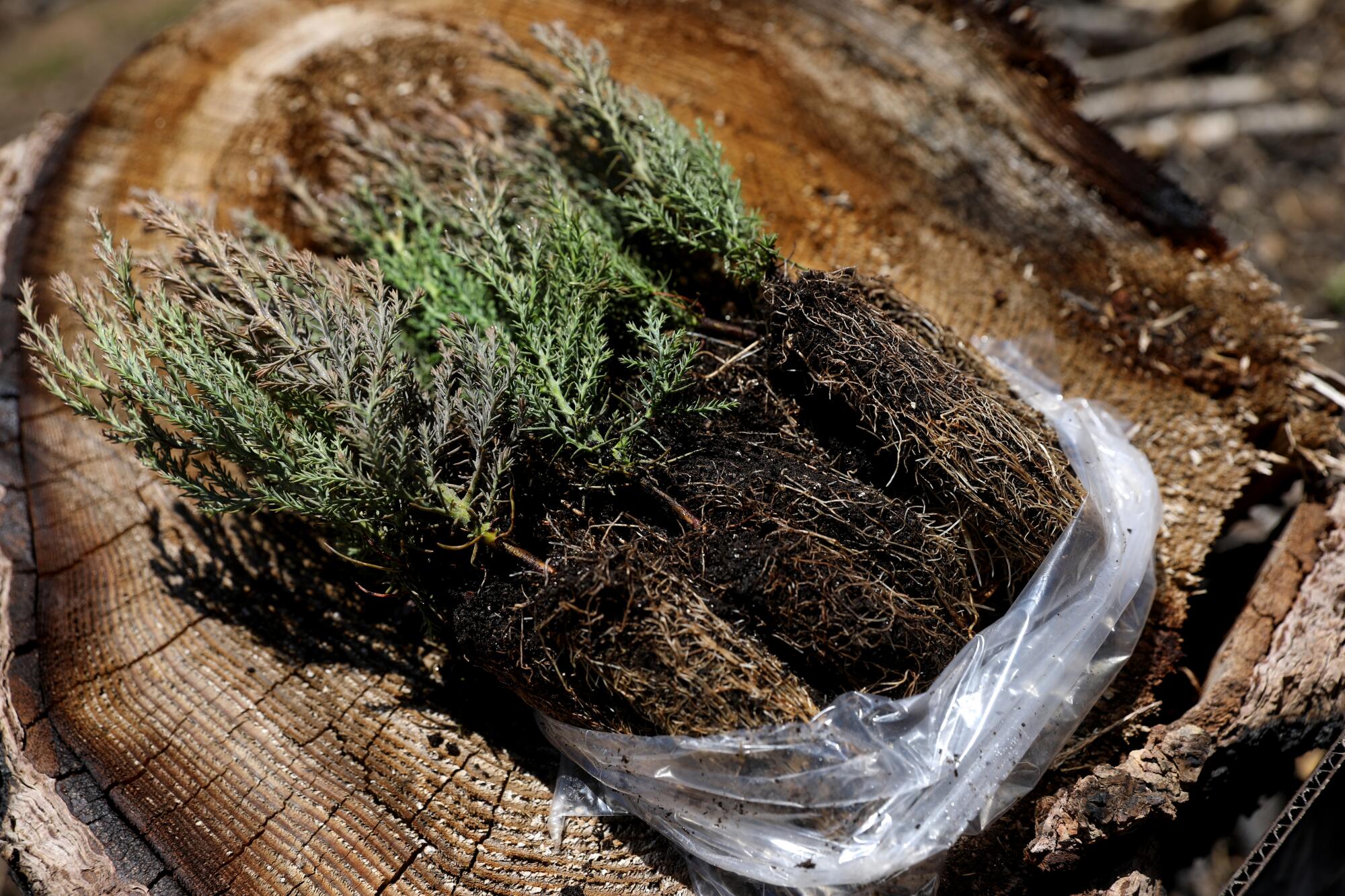
Until recently, no one thought reforestation efforts like these would be necessary to save giant sequoia groves, let alone from fire. The trees, which grow naturally only in a 60-mile band of forest on the western slopes of the Sierra, are adapted to thrive alongside flames. They have thick, armor-like bark, branches that reach above flames and cones that release seeds only in response to bursts of heat.
“There is essentially no historical record to suggest that these trees were ever killed by high severity fire,” said Borden, the league’s sequoia restoration and stewardship manager.
But over the past eight years, a string of wildfires has killed scores of sequoias by consuming their entire canopy. From 2020 to 2021 alone, three fires killed up to 19% of the world’s population of mature giants — statistics Borden refers to as “eradication numbers.”
“That shook us all to the core,” he said. “That made us realize everything that we thought about how giant sequoia reacted and were adapted to fire, that may have been true under conditions that we had 100 years ago. But not with the conditions that our forests are in today.”
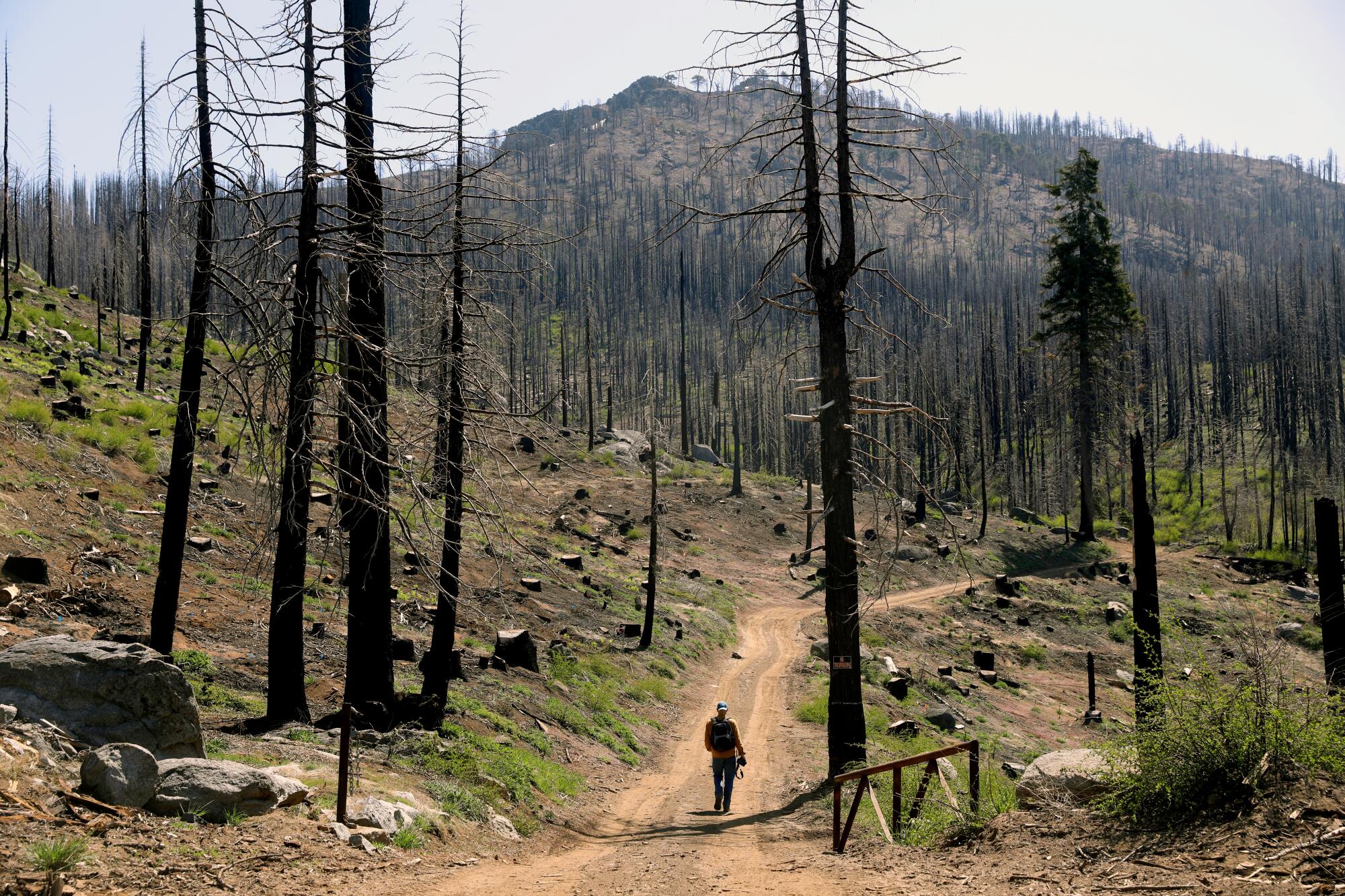
The Castle fire ignited amid a siege of dry lightning in the summer of 2020, less than a year after Save the Redwoods League had purchased 530 acres in the Alder Creek Grove. For weeks, president and CEO Sam Hodder anxiously monitored the fire’s progression. Then, over the course of a few hours Sept. 13, winds pushed flames over a ridge and onto the property.
Hodder knew the forest was in bad shape. For roughly a century, the landscape had been deprived of the lightning-sparked fires and cultural burning that once thinned trees and brush on a regular basis. Swaths of forest were in the process of growing back from generations of clear cutting, resulting in unnaturally dense, young and uniformly aged stands.
Scientists estimate there are now three to 10 times as many trees in the Sierra as there were in the 1900s. The increase wasn’t consistent among species. Conditions favored shade-tolerant trees — white fir, red fir and incense cedar — that prefer dense, closed canopies. These trees burn more easily than fire-adapted species like pine and sequoia that once dominated the forest. And they can act as ladders that carry flames into the canopies of the larger trees.
On top of this, hotter, drier conditions due to climate change had resulted in scores of standing dead trees and parched vegetation that was primed to burn.
As California struggles with an increase in extreme wildfires, researchers are studying exactly what a healthy or fire-resistant forest looks like.
Nonetheless, Hodder was surprised by the devastation. The fire had killed 200 mature giant sequoias in the grove, 80 of them on the nonprofit’s property. Rangewide, some 10,000 sequoias died.
“There’s nothing that prepares you for walking through a charred landscape with these skeletons of trees that were 2,000, 3,000 years old,” he said.
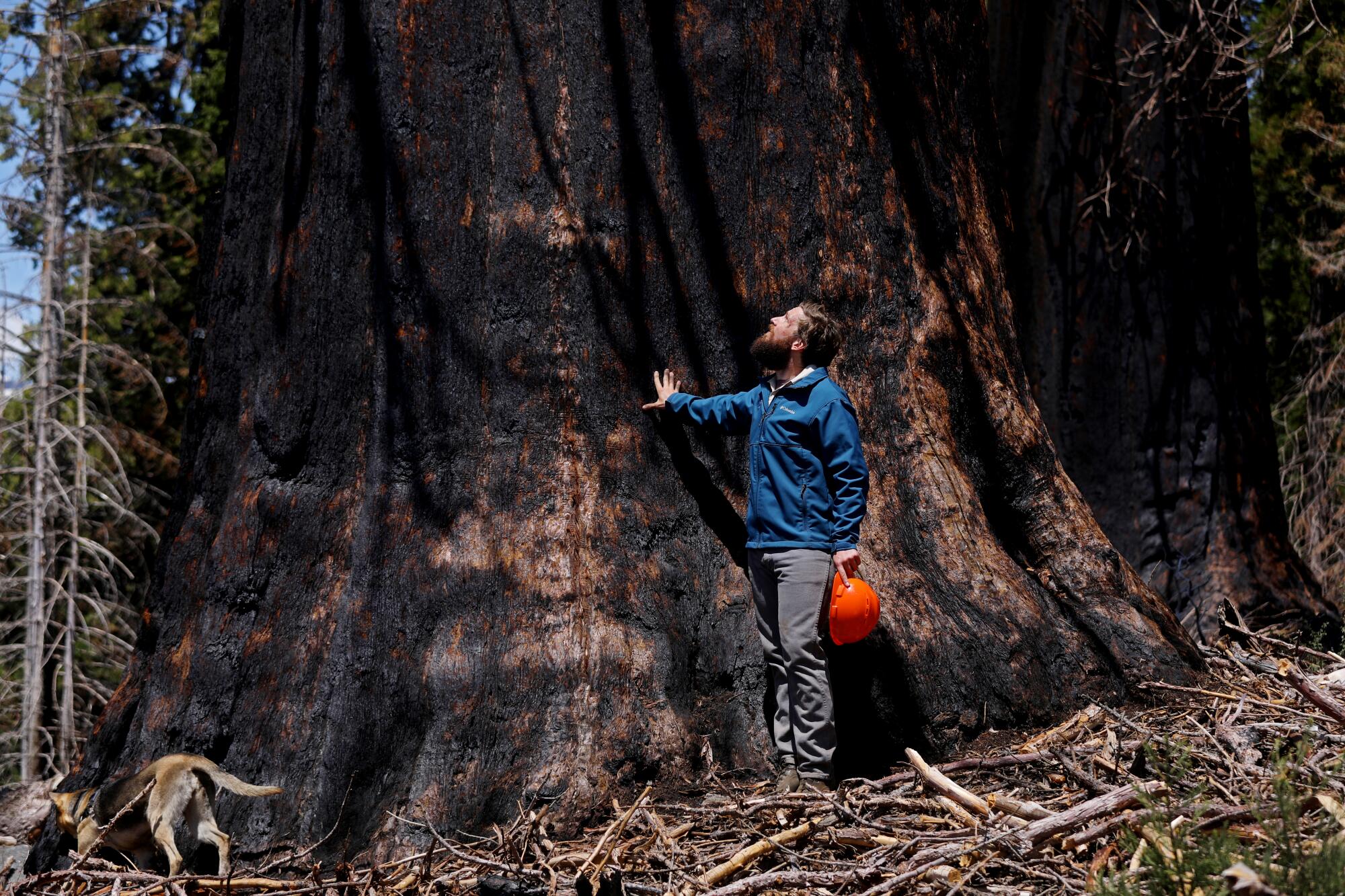
Staffers waited for another season to see whether natural regeneration would take place. In areas that experienced low to moderate-intensity fire, green carpets of sequoia seedlings sprouted. But in about 225 acres of severely burned grove, nothing came up but shrubs.
The burned portion of the property is now a mosaic of dead, toothpick-like trees, or snags, interspersed with areas that have been cleared for planting.
Until recently, it was covered in snow from a historically wet winter that completely buried the yurt Borden lives in during the summer. Runoff coated hillsides with slicks of shin-deep mud and sent piles of earth crashing down onto the roads winding up the mountain.
Although the weather posed logistical challenges, it provided a rare gift to the sequoia seedlings, which need lots of water.
This year’s Castle fire killed hundreds of giant sequoias, the latest in a string of Sierra Nevada wildfires that is taking an alarming toll on the world’s most massive trees.
In mid-April, Borden began coming up once a week to measure the snow. The goal was to plant immediately after it melted, when the soil moisture was highest.
Conditions aligned in late May, setting off a tightly coordinated chain of events that was several years in the making. Borden lined up a forester and contracted with a crew that travels around the state chasing the planting season.
Seedlings were gathered from the nursery where they’d been growing in containers for a year. The seeds that spawned them were extracted from cones from the nearby Wishon sequoia grove, whose climate and elevation most closely resembles that of Alder Creek.
They were loaded into boxes and placed in cold storage at the Forest Service office in Springville, to be retrieved the morning of the planting.
The week before, graduate students from UC Berkeley had marked the spots where seedlings should be planted with small blue flags.
The planting at Alder Creek Grove is not just a preservation effort, it’s also an experiment.
“Ultimately, what I want to know is how we actually can recruit or develop monarch trees,” said Rob York, professor of Cooperative Extension, who is leading the study.
York plans to hold a prescribed burn in the grove in about 12 years to mimic the natural pace of fire in the forest. He wants to determine how densely giant sequoia seedlings should be planted now to ensure the grove thrives after that burn.
“Every time we do a prescribed burn, we expect the fire to kill some of the trees,” he said. “But we’ve never done the math really to figure out, given an active fire frequency in a young stand, how many seedlings we need to start out with.”
York is also testing whether dense plantings will inhibit the growth of shrubs that could crowd out young trees.
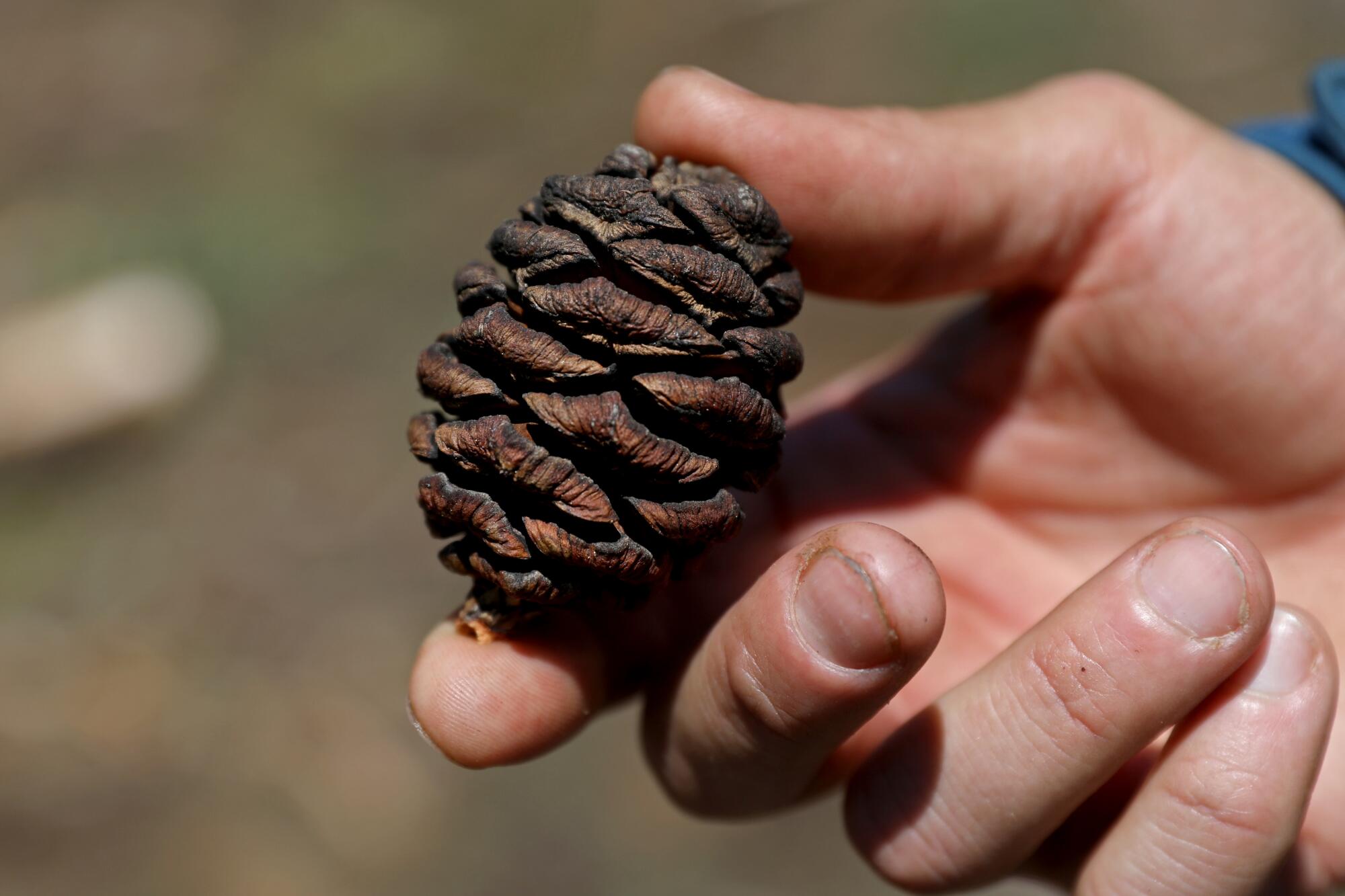
This most closely resembles how giant sequoia regenerate naturally. Each mature tree can produce 3 billion to 4 billion seeds over the course of its lifetime, and after low- to moderate-intensity fire opens cones, seedlings sprout up in thick mats. This appears to be an adaptation to the fact that many young trees won’t make it.
Young sequoias can be killed by thirst and by fire. The trees don’t develop the classic fire-resistant characteristics — thick bark that protects the inner cambium and self pruning that sees them shed lower branches — until they reach about 500 years old.
After that happens, giant sequoias are mostly killed by old age. At least that’s how it used to work, Borden said as he stood in front of a gnarled trunk that reached several stories high. The top half of the tree had fallen to the ground beside it. He estimates it was about 2,000 years old when the Castle fire burned it from the inside.
“That tree actually was still burning a year after the fire,” he said. “We were seeing smoke from this fire last fall — so two years after — on some pieces.”
Nearby, a singed giant bore a single clump of green high up in its branches. “Still alive, but likely on life support,” he said.
On the other side of the ridge behind Borden was the portion of the property the Castle fire didn’t reach. The slope was thick with trees: big broccoli-topped sequoia pressed up against smaller fir and cedar, their branches reaching down to the forest floor.
This was what the rest of the grove looked like before the fire, Borden said. The hillside hasn’t burned since at least the 1940s, but it’s time to prepare for the inevitability that it will, he said.
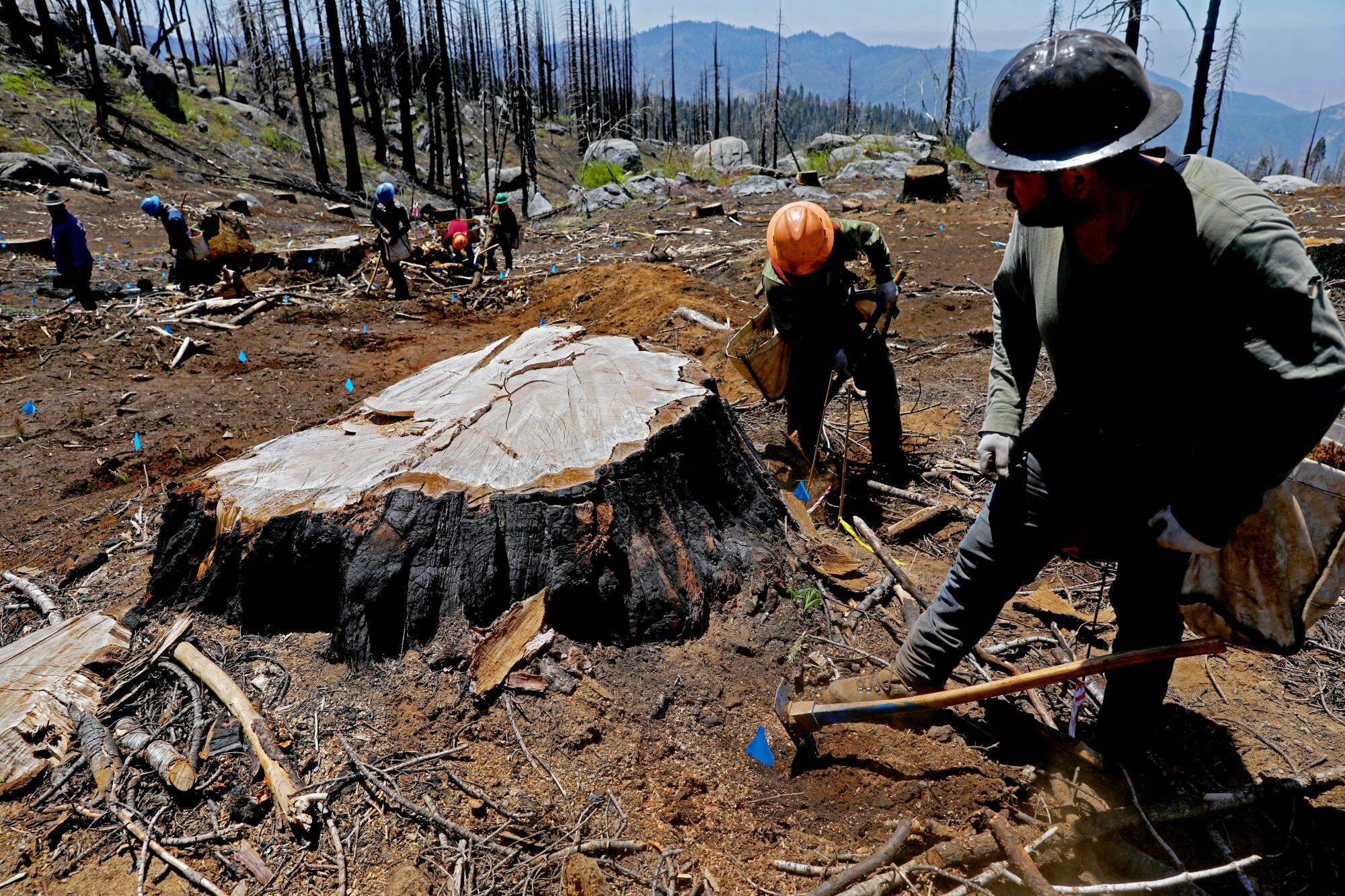

Save the Redwood League’s next project, slated to start in July, is to remove some fir and cedar from this area by piling and burning the trees and brush or trucking them away, and then to introduce prescribed burning, Borden said. They are partnering with nonprofit Calaveras Healthy Impact Product Solutions, which is putting together a workforce of Indigenous community members.
The goal is to restore the entire property to a state where it can be maintained by fire — either intentionally set or naturally sparked — that will do good ecological work rather than devastating damage.
All this work doesn’t come cheap. Save the Redwoods League has spent about $2 million on the replanting alone. The seedlings cost about 50 cents apiece to grow and an additional 90 cents to plant. The nonprofit was able to recoup about $800,000 from selling some of the trees that were removed to a lumber mill.
In addition, the probability of any one seedling becoming a monarch — the largest-size class of giant sequoias — is low. A handful might make it to 1,000 years. The chance of one living to 3,000 years? Borden guesses it might be one in 10 billion.
But it’s important to try, he said, ticking off the reasons: Without restoration and resilience work, this piece of forest will likely convert to shrubland dominated by manzanita, whitethorn and chokecherry. This forest type holds back much less water and stores much less carbon, which are key to slowing climate change.
Culturally, the trees, which Borden describes as “straight out of Dr. Seuss,” inspire child-like awe, drawing visitors from all over the world.
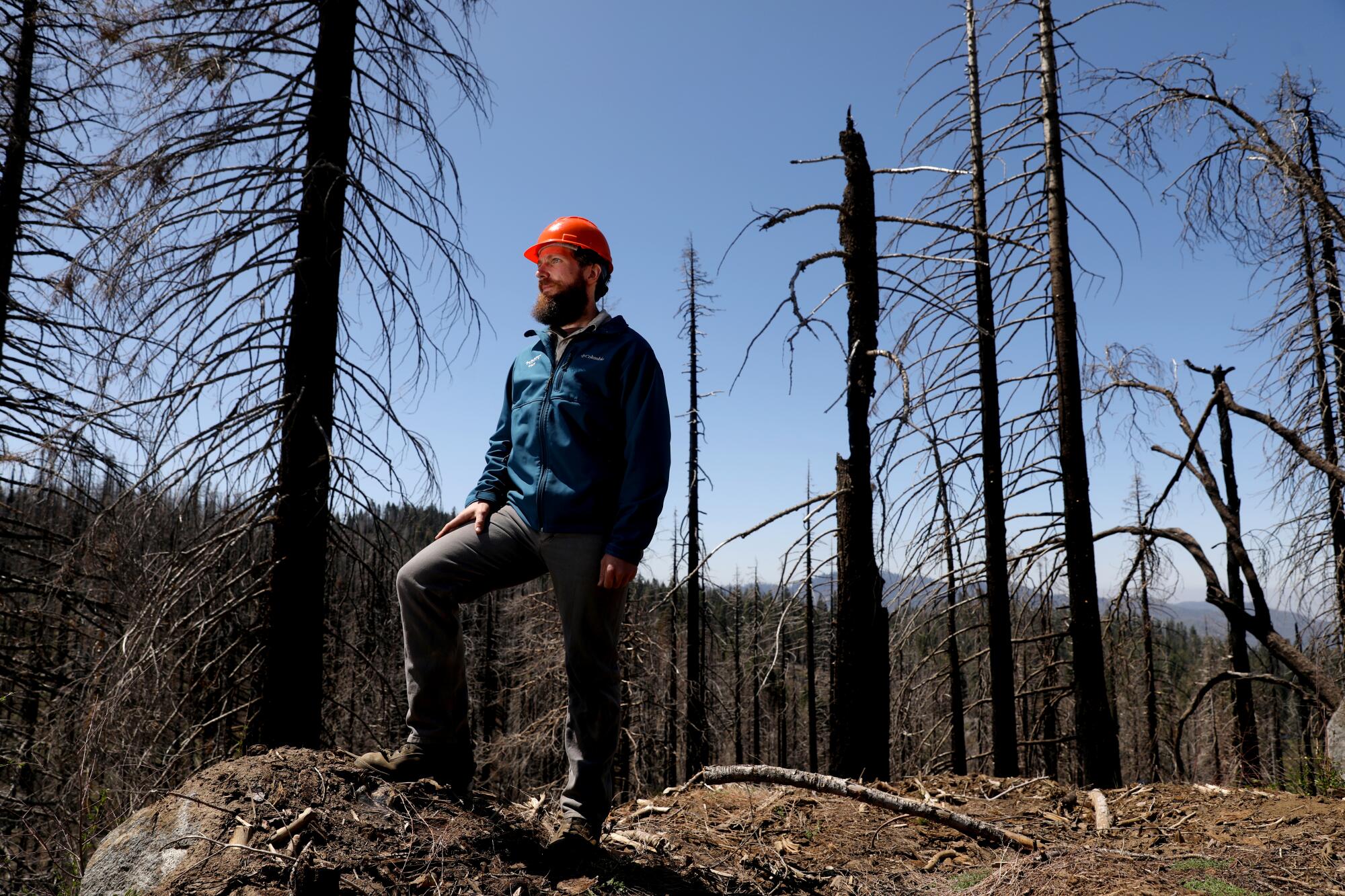
And morally, it’s the right thing to do, he said.
“Humans got us into this mess by Indigenous removal, fire suppression and then climate change,” he said. “We put these forests in these conditions. And we have, I believe, the responsibility to do everything we can to rectify those conditions that we created as best as we can. It’s a reconciliation.”
Borden regarded the planting site below him, with its bald spots and raked-over soil, and recoiled. It’s ugly, he admitted.
But he could also see what it will look like a decade down the road.
Some seedlings — maybe half of them — will have died but the remainder will be 20 to 30 feet tall. Their crowns will overlap in places, forming a wall of green foliage.
And maybe, in another couple hundred years, some of them will grow into giants.
